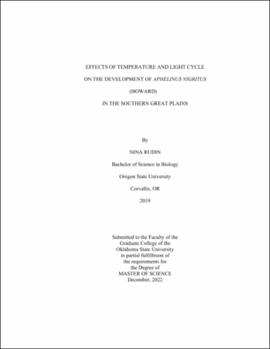| dc.contributor.advisor | Giles, Kris | |
| dc.contributor.author | Rudin, Nina | |
| dc.date.accessioned | 2023-09-21T20:34:34Z | |
| dc.date.available | 2023-09-21T20:34:34Z | |
| dc.date.issued | 2022-12 | |
| dc.identifier.uri | https://hdl.handle.net/11244/339609 | |
| dc.description.abstract | The Southern Plains of North America are a humid subtropical region. Drastic temperature changes are common, but multivoltine insects must adapt to allow their offspring to survive. In agricultural crops it is important to understand how climate and weather can influence pests and their natural enemies. With the introduction of sorghum aphids (Melanaphis sorghi) into the area, the abundance of Aphelinus nigritus has increased. Studies suggest a correlation between sugar cane aphid populations and A. nigritus parasitism rates, yet very little is known about this species developmental requirements or how they transition to and survive cold winter months. | |
| dc.description.abstract | This study consists of three experiments across two objectives. Objective i was to determine lower temperature thresholds and degree-day requirements for A. nigritus development and objective ii was to characterize the effects of photoperiod and temperature on A. nigritus development. In objective I microcosms were placed in one of four environmental chambers maintained at constant temperatures and one fixed light-dark cycle: 14, 18, 22, and 26ºC each at 16:8 L:D cycle. The number of days from oviposition to mummy, mummy to adult, and oviposition to adult were recorded, and each individual's developmental rate (1/days) was calculated for the three described developmental periods. Total development (Oviposition to Adult) ranged from 12.8-45.4 days. On average, the total degree day requirement of A. nigritus was 216.15 degree days with an average lower developmental threshold of 9.064ºC. In objective ii microcosms where maintained at one of 6 temperature fluctuation x day length environmental conditions (14-10ºC and 28-24ºC daily fluctuations each at 15:9 L:D, 12:12 L:D, and 9:15 L:D) to assess how these conditions influenced growth and development of offspring. We assessed the effect of parental exposure to environmental change and immature exposure to environment change. Results indicate that exposure to lower fluctuating temperatures and shorter days cause delays in development greater than those expected for A. nigritus. Delayed development associated with the onset of average winter conditions indicates that A. nigritus is entering oligopause. | |
| dc.format | application/pdf | |
| dc.language | en_US | |
| dc.rights | Copyright is held by the author who has granted the Oklahoma State University Library the non-exclusive right to share this material in its institutional repository. Contact Digital Library Services at lib-dls@okstate.edu or 405-744-9161 for the permission policy on the use, reproduction or distribution of this material. | |
| dc.title | Effects of temperature and light cycle on the development of Aphelinus nigritus (Howard) in the Southern Great Plains | |
| dc.contributor.committeeMember | Noden, Bruce | |
| dc.contributor.committeeMember | Michaud, JP | |
| osu.filename | Rudin_okstate_0664M_17972.pdf | |
| osu.accesstype | Open Access | |
| dc.type.genre | Thesis | |
| dc.type.material | Text | |
| dc.subject.keywords | Aphelinus nigritus | |
| dc.subject.keywords | aphid | |
| dc.subject.keywords | diapuse | |
| dc.subject.keywords | oligopause | |
| dc.subject.keywords | parasitoid | |
| dc.subject.keywords | sorghum | |
| thesis.degree.discipline | Entomology and Plant Pathology | |
| thesis.degree.grantor | Oklahoma State University | |
